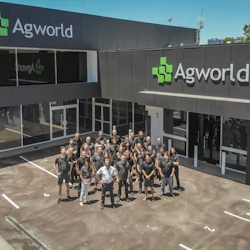With multi-spectral imagery, such as NDVI and many other variants, becoming more and more popular among growers and agronomists, we decided to add a layer of imagery to the Agworld platform at the end of 2018. After careful consideration, Agworld opted for Satamap’s SVI (Satamap Vegetative Index) layer, which is part of the PCT Agcloud suite of services. Agworld users have now had access to this imagery layer for almost 10 months and I get positive feedback from users almost on a daily basis. With the winter crop growing-season now in full swing in most parts of Australia, I thought it was a good moment to give an overview of some great use cases I have seen of the SVI layer in Agworld.
Those of you who count yourselves as members of ‘Ag-Twitter’ would have seen many recent tweets with two photos in them: an image of a field on one side and a spectral image of the same field on the other side. As an example: Warwick Holding, Pontara Grain, Yerong Creek, NSW has been using the SVI layer in Agworld to find the reason behind biomass differences in his fields. He has then used this knowledge to spot spray random patches of weeds or to make informed decisions about utilising companion crops with wheat, among other uses. We love seeing your tweets, Warwick!
Using a satellite image on @Agworld for site specific spraying a random patch of Lucerne flea in a wheat crop. pic.twitter.com/RXexnyAp9o
— Warwick Holding (@Pontaragrain) July 10, 2019
Kittyhawk wheat.
— Warwick Holding (@Pontaragrain) July 1, 2019
Nil companion plot.
Companions? = Field peas, Tillage Radish and Purple Top Turnip.
Tootool.
Obvious at all levels. pic.twitter.com/f00VKHBTks
When I spoke to Satamap Product Manager Ben Boughton recently, he explained to me that lots of growers have been able to use the SVI layer to their advantage this season: “With moisture being limited in most cropping areas, growers and agronomists have been able to see biomass accumulate differently in parts of their fields, depending on soil type. Lighter, more loamy soils have been able to produce more biomass with limited rainfall than heavier soils as they allow plants to make better use of limited moisture. In years when winter crops have a full moisture profile available on the other hand, we tend to see biomass accumulating more rapidly on heavy soils. With having this visibility and knowledge of their crops, growers and agronomists are able to really fine-tune their crop management and maximise their profit, whatever the conditions may be.”

Got what it takes to join the Agworld team? We’re looking for talented individuals to help us deliver innovative solutions in agriculture.
Ben also told me that it is the scale of the SVI layer that makes it so unique in comparison to other multi-spectral imagery sources: “Because SVI is based on a set scale, users are able to compare crop growth from one date to another, across multiple fields or even the whole farm! Where most providers set their scale with the aim to show maximum in-field variability, we aim to show the most accurate ‘snapshot’ of crops and an overview that is easily comparable. Earlier this year we increased the sensitivity at the lower end of the SVI spectrum so it can pick up emerging crops in more detail without getting too much distortion from differences in stubble or soil. Because this is all done on a set scale, growers and agronomists can see biomass accumulate as the season progresses and use it to determine crop stages in different parts of the field.”
Agworld is all about making data available to our users in an easy to understand format, wherever they are - SVI is a great example of adding another ‘tool’ to our users’ ‘toolbox’ and enabling them to make better decisions in the field. As Cassie Turner, an agronomist with CQ Ag Services in Emerald, QLD recently told us: "I love having access to the SVI layer in Agworld. No need to use different apps or different sources of information; it’s right here where I need it in Agworld."
If you have any questions about how you can make use of the SVI layer in Agworld, please don’t hesitate to contact me on +61 8 6230 2290; I’d love to have a chat to you.





